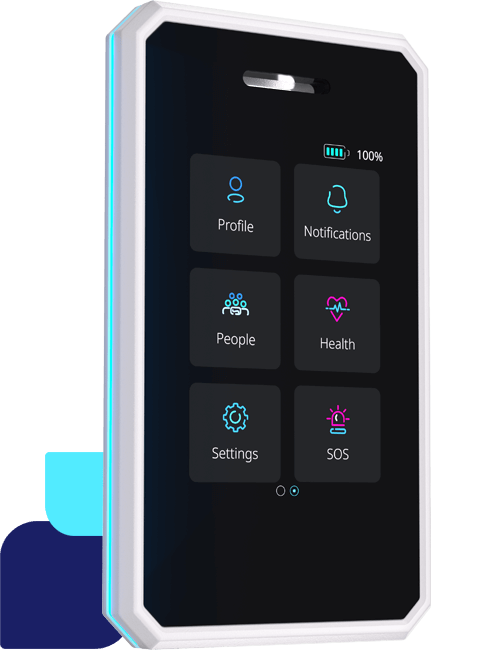Real time location systems have so much potential to improve worker safety. You might notice I’ve covered this a few times already, when talking about supporting lone workers, the benefits of person level accuracy, as well as attending sites and completing tasks.
Health & safety at work receives a massive amount of attention from law makers, trade unions, as well as individual employees. And in most cases, for good reason. So, if you haven’t already, perhaps it is time you started improving safety in your workplace for your frontline staff.
In this article we explore how the wearable Sense Badge can act as a guardian for your staff, protecting them against potential dangers as they go about their work.
The Sense Badge alerts staff in unsafe situations
Sense Badges can act as a guardian for your employees, through automated safety alerts – either as pre-built apps that come as standard with your Sense solution, or through custom workflows you’ve built yourself.
Whether the alert is fall-detection, changing temperature or unsafe air quality; users can remove themselves from unsafe situations, or better still, avoid them completely. Sense can even integrate with vehicle telemetry data to warn drivers of erratic driving or to slow down.
There are a wide range of safety features and use cases. For example, with the right workflow, users could be denied access to an area if they haven’t signed out the correct safety equipment, or if the area is deemed unsafe.
Managing tasks safely
When your teams are using the Sense solution, tasks can be routed to the people with the correct qualifications to use necessary equipment, ensuring unqualified individuals aren’t being asked to complete work they aren’t trained for.
Sense Badges can also be used to detect if the necessary safety equipment has been signed out to complete the task and remind users if they have not got what they need, alert health and safety officers, and prompt employees to stop what they are doing if they are not using safety equipment.
This can work well in warehouses, where forklift or other equipment requires a certain licence, or where heavy lifting equipment may be required. At a construction site, too, you may wish to ensure workers are using hard hats and steel toecaps.
Workflows created in the Sense software allow managers to assign tasks based on whatever parameters they choose, while also linking these tasks up to custom alerts or warning triggers.
SOS alerts
SOS alerts are a special type of alert within the Sense Badge. They can be activated manually, or automatically, such as if a remote or lone worker doesn’t check-in during their pre-determined window.
SOS alerts can be sent to management, or to nearby colleagues, to request assistance when an employee is feeling unsafe, or threatened, or if an accident has occurred. This includes automatic fall detection. Sending alerts to the nearest employee, and giving them directions to the person who needs help, can reduce response times and improve outcomes for those involved.
This can help in a wide range of workplaces, especially for teams who work in the community or regularly travel between sites.
Environmental monitoring
Environmental monitoring helps to detect light leaks at the point of occurrence during work. This can help to trigger evacuation and get a fast response before the problem escalates beyond control. It can also trigger the use of other systems by trained employees to further investigate issues, by creating an emergency task in an individual’s workload or sending a safety alert to the relevant teams.
Each Sense Badge is equipped with sophisticated environmental monitoring technology, which can be useful in a variety of scenarios. For example, in a hospital room where oxygen tanks are in use, or any location where potentially dangerous gases might be present in large quantities.
Managing evacuation
The Sense Badge can act as a guardian to ensure everybody is accounted for during an evacuation or other emergency.
During an evacuation, live location data allows managers to see where staff are. This helps to ensure everyone is at the designated meeting point, or that everyone is marked as safe. This means fire marshals can speed up the response to those who need assistance, in a location that isn’t safe. It also means those with specific evacuation needs can be monitored and helped safely.
Evacuation functionality works best on sites where employees work regularly, and where everyone is equipped with a Sense Badge.
Lone workers
GPS tracking for lone workers, such as delivery drivers, allows management to check they have reached their destination safely, and check-in if a problem has occurred. These regular check-ins help to ensure lone worker wellbeing and can help to prevent issues from escalating where it is avoidable.
Lone workers can often go hours without contact whilst out and about, so keeping in touch can not only improve safety and wellbeing, but engagement and productivity too.
Timed check-ins are a discreet way to help lone workers know that they will be assisted if they fail to let their supervisor know they are safe, for example every 15, 30, or 60 minutes.
Protecting your fleet of drivers
Drivers are typically working alone, often driving long distances, which can be tiring. They could also be driving quickly to beat traffic or meet KPI’s.
Fleet vehicles usually have some form of tracking providing telemetry data that can be reviewed later, however, these systems usually lack an element of last mile communications that can tell the driver to be more careful. By connecting the telemetry system API with Sense, last mile communications can be triggered by events such as erratic driving or speeding, that then sends an automated alert telling the driver to take a break or slow down.
The Sense Badge is a simple way to help improve road safety of your drivers and other drivers on the roads.
Location awareness for guests & patients
Location awareness can be extended to guests and patients, using wristbands. For example, in a hotel retreat, or hospital.
Giving out wristbands allows the business to control access to areas and alert staff when an unauthorised individual leaves a designated zone.
This functionality doesn’t just seek to improve customer experience, it can also be used for evacuation management and safety of patients and guests, as well as to improve service design.
Your Sense solution protects your staff, patients and guests
The Sense solution connects your systems and workflows to give you full, end-to-end protection – including last mile communications to your frontline staff.
Equipping your staff with Sense Badges connects them to your Sense ecosystem, and serves as their guardian, providing automatic safety alerts, lone worker check-ins and support, fall detection, and environmental monitoring.
Combining this with wristbands and tags can help improve employee, guest, and patient safety.
If you’re interested to learn more about how Sense can protect people in and around your business, speak to one of our consultants today.







